Sharks, the apex predators of the oceans, have captured the human imagination for centuries. Revered for their evolutionary prowess and feared for their powerful presence, these ancient creatures play a vital role in marine ecosystems. From the iconic great white shark to the elusive hammerhead, each species possesses unique features that contribute to the awe and mystique surrounding them.
In this exploration of the 10 most famous and popular shark species, we delve into their distinctive characteristics, habitats, and cultural significance. Beyond their portrayal in media and folklore, these sharks are essential components of oceanic balance, commanding both respect and conservation efforts.
Join us on this journey through the depths of the ocean as we unravel the fascinating stories of these remarkable creatures and shed light on their crucial role in maintaining the delicate equilibrium of our planet’s vast and awe-inspiring marine landscapes.
1. Great White Shark (Carcharodon carcharias)

Geographical Distribution:
Great white sharks are found in coastal waters of all major oceans, preferring cool and temperate regions. They inhabit areas such as the coasts of South Africa, California, Australia, and the Mediterranean.
Physical Appearance:
- Distinctive Coloration: Gray or blue-gray on the upper body, transitioning to a white underbelly.
- Formidable Size: Adults can reach lengths of 15 to 20 feet, with some individuals exceeding 20 feet.
- Iconic Shape: Characterized by a torpedo-shaped body and a large, triangular dorsal fin.
Food and Diet:
- Apex Predators: Known as apex predators, great whites prey on seals, sea lions, and various fish species.
- Ambush Predators: Employ a stalking approach and burst of speed to surprise their prey near the water’s surface.
Mode Of Reproduction:
- Viviparous: Give birth to live young after an internal gestation period.
- Low Reproductive Rate: Produce a small number of pups, emphasizing the vulnerability of the species.
Conservational Status:
- Vulnerable: Despite their fearsome reputation, great whites face threats from overfishing, habitat degradation, and accidental capture.
Interesting Facts:
- Curiosity Factor: Known for investigating objects by mouthing or bumping them, possibly driven by curiosity.
- Longevity: Great whites can live for several decades, with estimates ranging from 30 to 70 years.
2. Hammerhead Shark (Sphyrnidae Family)
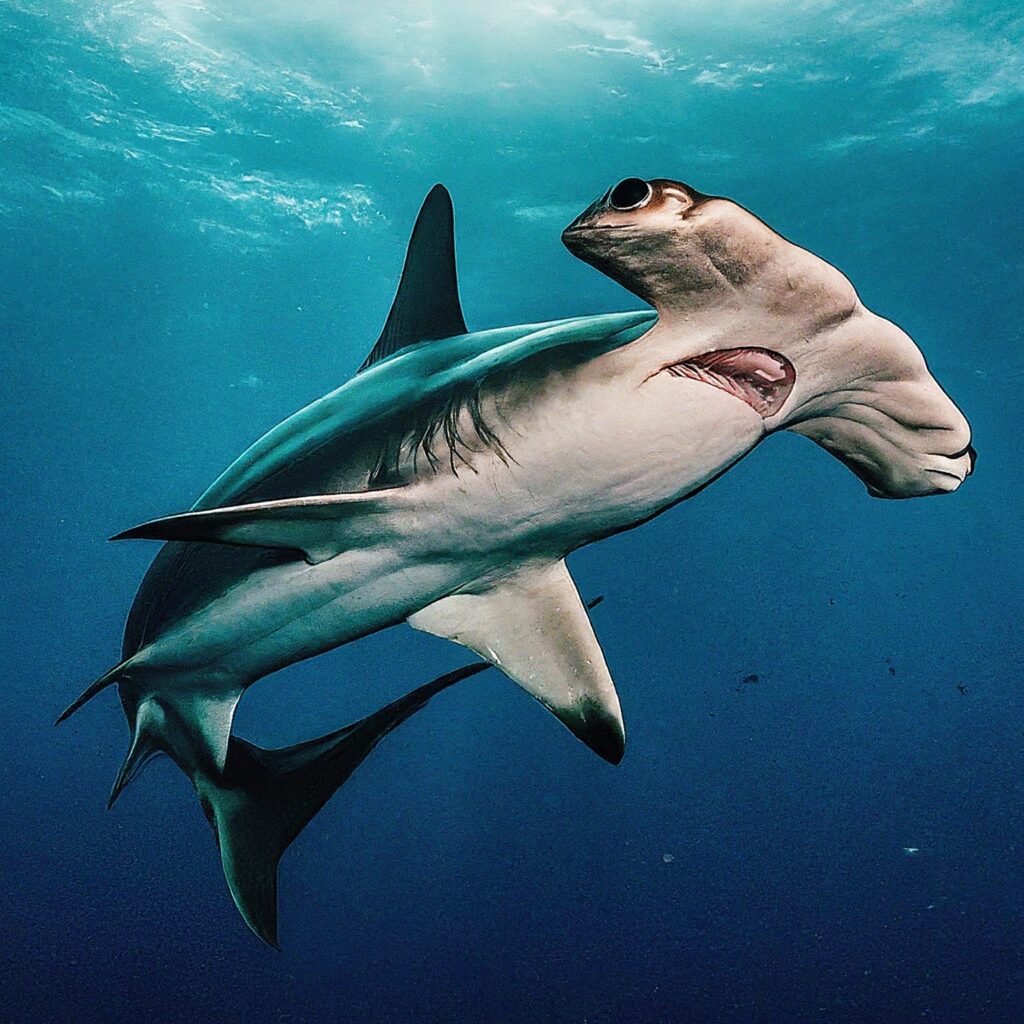
Geographical Distribution:
Hammerhead sharks are distributed worldwide in both coastal and offshore waters, with varying species occupying different regions.
Physical Appearance:
- Unique Head Structure: Distinctive hammer-shaped head, known as a cephalofoil.
- Varied Sizes: Different species exhibit varying sizes, with the largest reaching lengths exceeding 20 feet.
Food and Diet:
- Varied Diet: Feed on fish, rays, and smaller sharks.
- Electroreception: Use their wide-set eyes to detect prey more efficiently.
Mode Of Reproduction:
- Viviparous: Give birth to live young, with gestation periods ranging from 9 to 12 months.
Conservational Status:
- Threatened: Hammerhead populations face threats from overfishing, especially for their fins, which are in demand for shark fin soup.
Interesting Facts:
- Schooling Behavior: Some hammerhead species exhibit schooling behavior, enhancing their predatory efficiency.
- Enhanced Vision: The unique head shape provides an increased field of vision.
3. Tiger Shark (Galeocerdo cuvier)
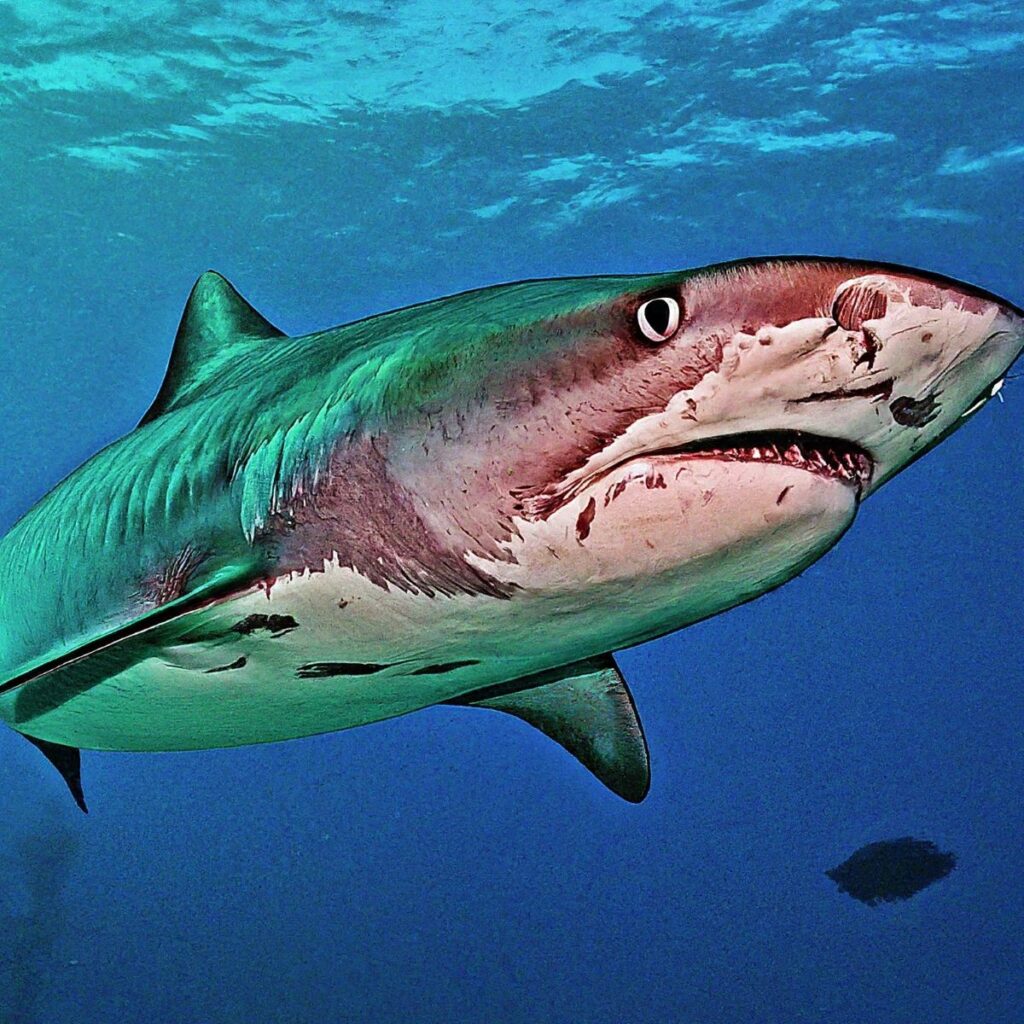
Geographical Distribution:
Tiger sharks are found in warm and tropical waters, ranging from the coast to the open ocean. They inhabit regions across the globe.
Physical Appearance:
- Signature Stripes: Named for the dark, vertical stripes along their bodies.
- Robust Build: Thick and powerful body, well-adapted for a wide range of habitats.
Food and Diet:
- Opportunistic Feeders: Known for consuming a wide variety of prey, including fish, turtles, birds, and even mammals.
- Scavenging Behavior: Act as opportunistic scavengers, feeding on carrion.
Mode Of Reproduction:
- Viviparous: Give birth to live young after a gestation period of approximately 16 months.
Conservational Status:
- Near Threatened: While not currently classified as endangered, tiger sharks face threats from overfishing and habitat loss.
Interesting Facts:
- Powerful Bite: Tiger sharks have a powerful bite force, allowing them to consume hard-shelled prey.
- Nomadic Nature: Exhibit a nomadic lifestyle, covering vast distances in search of food.
4. Whale Shark (Rhincodon typus)
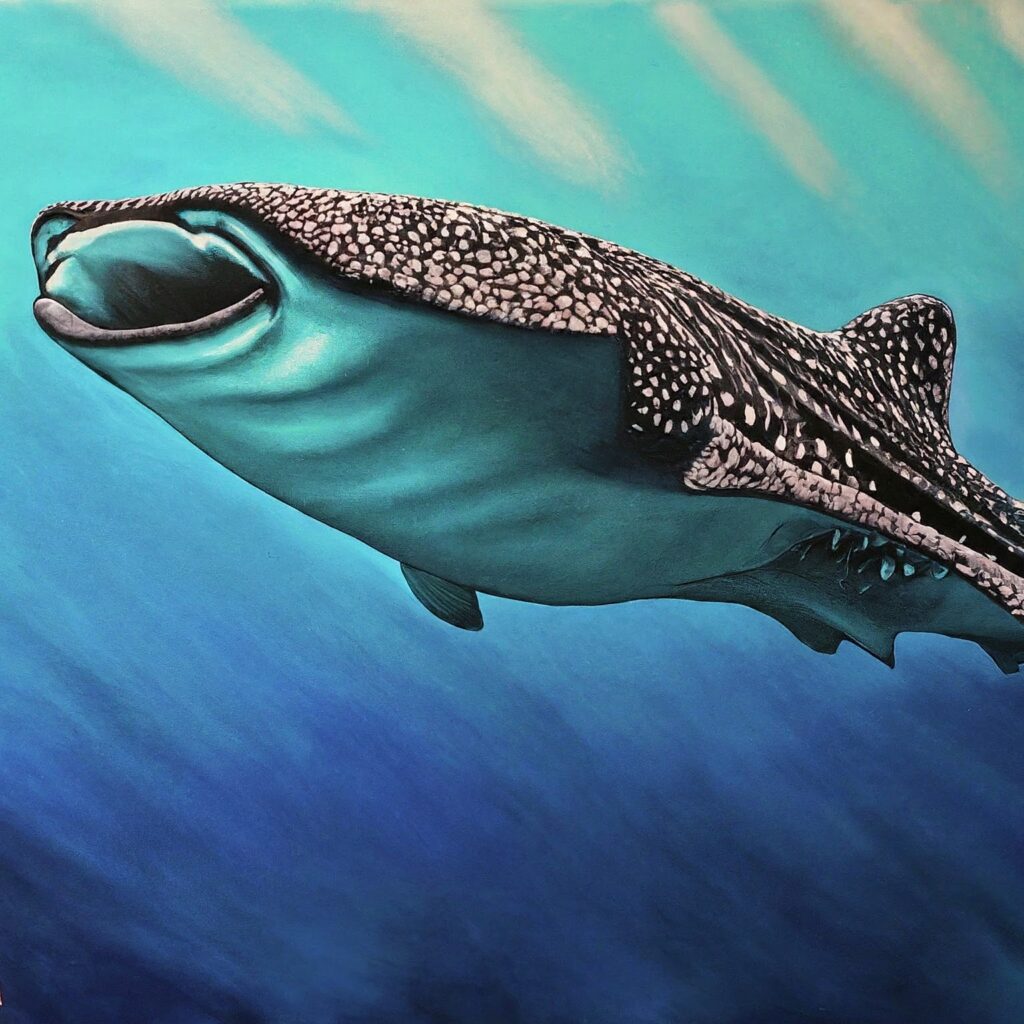
Geographical Distribution:
Whale sharks are found in tropical and warm-temperate seas, often near the surface. They have a widespread distribution, occurring in various oceanic regions.
Physical Appearance:
- Gargantuan Size: The largest fish species, with individuals reaching lengths of up to 60 feet.
- Distinctive Markings: Covered in a checkerboard pattern of light spots and stripes.
Food and Diet:
- Filter Feeders: Primarily feed on plankton, small fish, and other microscopic organisms.
- Gentle Feeding Behavior: Swim with their mouths open to filter food from the water.
Mode Of Reproduction:
- Ovoviviparous: Develop eggs within the female’s body, with live pups hatching and immediately swimming away.
Conservational Status:
- Vulnerable: Despite their wide distribution, whale sharks face threats from boat strikes, fishing gear entanglement, and habitat degradation.
Interesting Facts:
- Longevity: While estimates vary, whale sharks are believed to have a lifespan of up to 70 years.
- Global Travelers: Known for long-distance migrations, often traversing entire ocean basins.
5. Mako Shark (Isurus oxyrinchus)
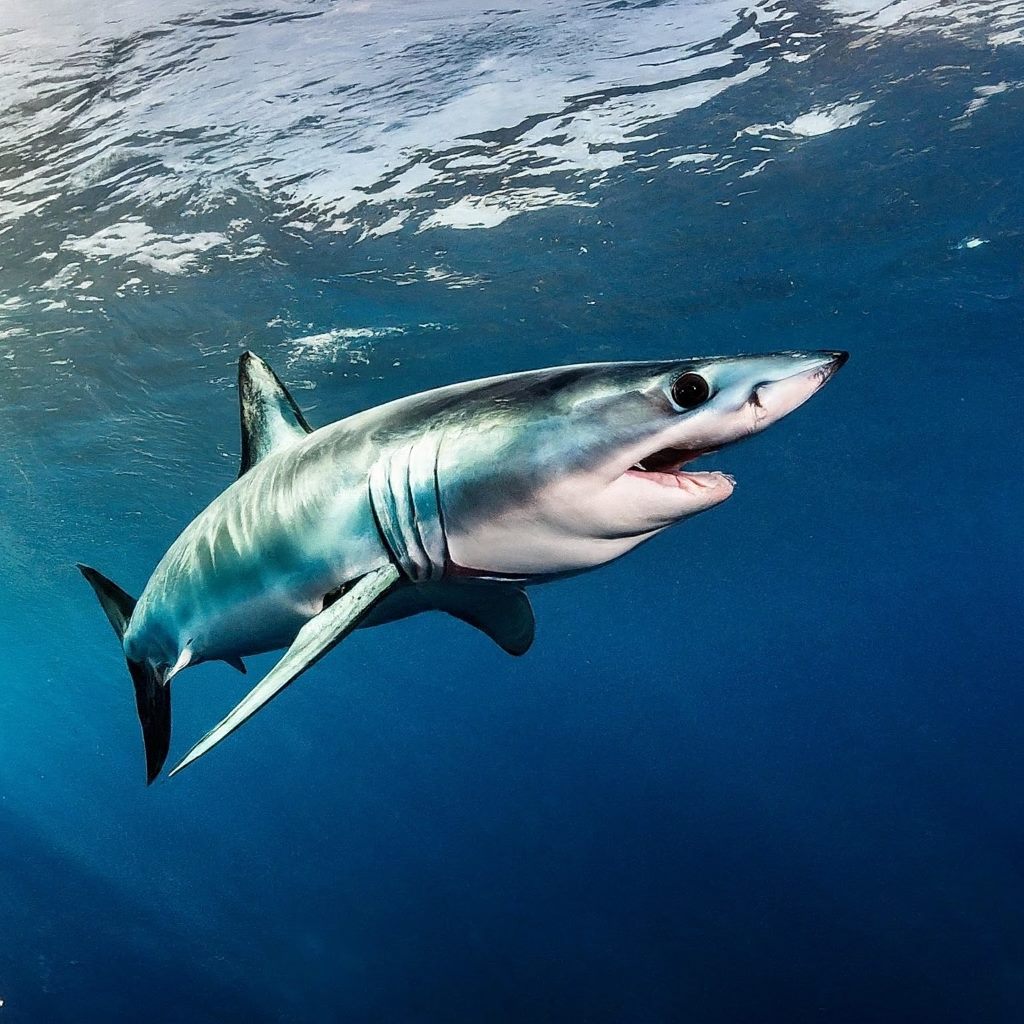
Geographical Distribution:
Mako sharks are found in both offshore and deep-sea environments, with a wide distribution in temperate and tropical seas.
Physical Appearance:
- Sleek and Streamlined: Possess a streamlined body with pointed snouts and large, expressive eyes.
- Vibrant Coloration: Blue or metallic coloration on the upper body and white on the underbelly.
Food and Diet:
- Speedy Predators: Known for their incredible speed, mako sharks are adept at hunting fast-swimming prey.
- Pelagic Diet: Consume various fish species, including tuna and swordfish.
Mode Of Reproduction:
- Ovoviviparous: Develop eggs within the female’s body, giving birth to live young.
Conservational Status:
- Vulnerable: Overfishing poses a significant threat to mako shark populations, particularly due to their value in the fin trade.
Interesting Facts:
- Speed Records: Mako sharks are among the fastest-swimming sharks, capable of reaching speeds up to 60 mph.
- Jumping Behavior: Known for breaching the water surface, leaping into the air, and spinning.
6. Basking Shark (Cetorhinus maximus)

Geographical Distribution:
Basking sharks inhabit cold to temperate waters and are commonly found in the Atlantic and Pacific Oceans.
Physical Appearance:
- Gigantic Size: Second only to the whale shark in size, with individuals reaching lengths of up to 40 feet.
- Filter-Feeding Adaptations: Enormous mouths with specialized gill rakers for feeding on plankton.
Food and Diet:
- Filter Feeders: Consume plankton and small fish by swimming with mouths wide open, filtering water through their gill rakers.
Mode Of Reproduction:
- Ovoviviparous: Develop eggs within the female’s body, with live pups hatching internally.
Conservational Status:
- Vulnerable: Basking sharks face threats from fisheries and accidental capture in fishing gear.
Interesting Facts:
- Surface Basking: Often seen near the water’s surface, leading to their name.
- Mysterious Migrations: Little is known about their migratory patterns and behavior.
7. Nurse Shark (Ginglymostomatidae Family)
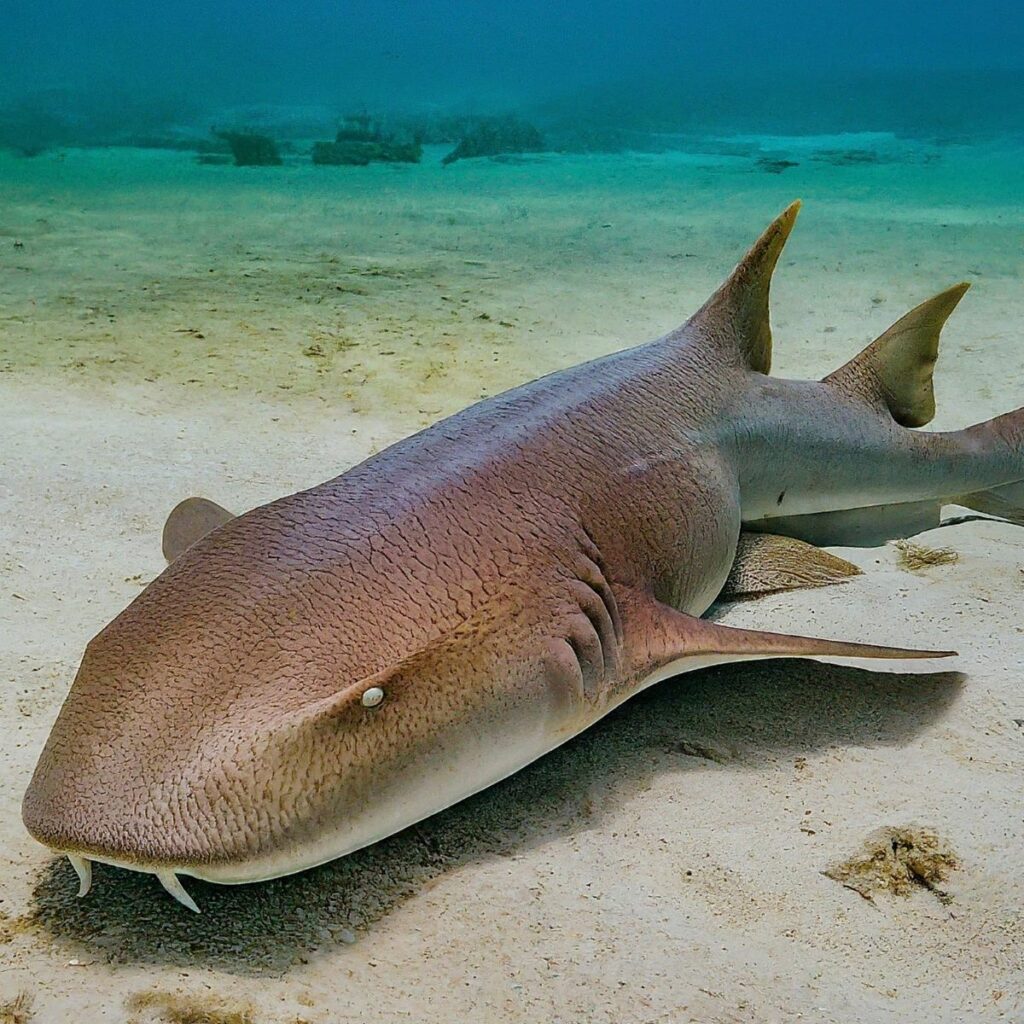
Geographical Distribution:
Nurse sharks are found in warm, shallow waters, primarily in the Atlantic and eastern Pacific Oceans. They often inhabit coral reefs and sandy bottoms.
Physical Appearance:
- Sluggish Swimmers: Possess a distinctive, broad head and small eyes, with a catfish-like appearance.
- Max Size: While not as large as some other shark species, nurse sharks can reach lengths of 10 feet.
Food and Diet:
- Benthic Feeders: Feed on the seafloor, consuming a diet of crustaceans, mollusks, and small fish.
- Nocturnal Hunting: Prefer to hunt at night, using their strong jaws to crush shellfish.
Mode Of Reproduction:
- Ovoviviparous: Female nurse sharks carry eggs within their bodies until they hatch internally, giving birth to live pups.
Conservational Status:
- Least Concern: Nurse sharks are not currently facing significant threats and are relatively common in their habitats.
Interesting Facts:
- Resting Behavior: Nurse sharks are often observed resting on the seafloor during the day.
- Social Groups: Exhibit social behavior, with groups of nurse sharks sometimes resting together.
8. Blue Shark (Prionace glauca)
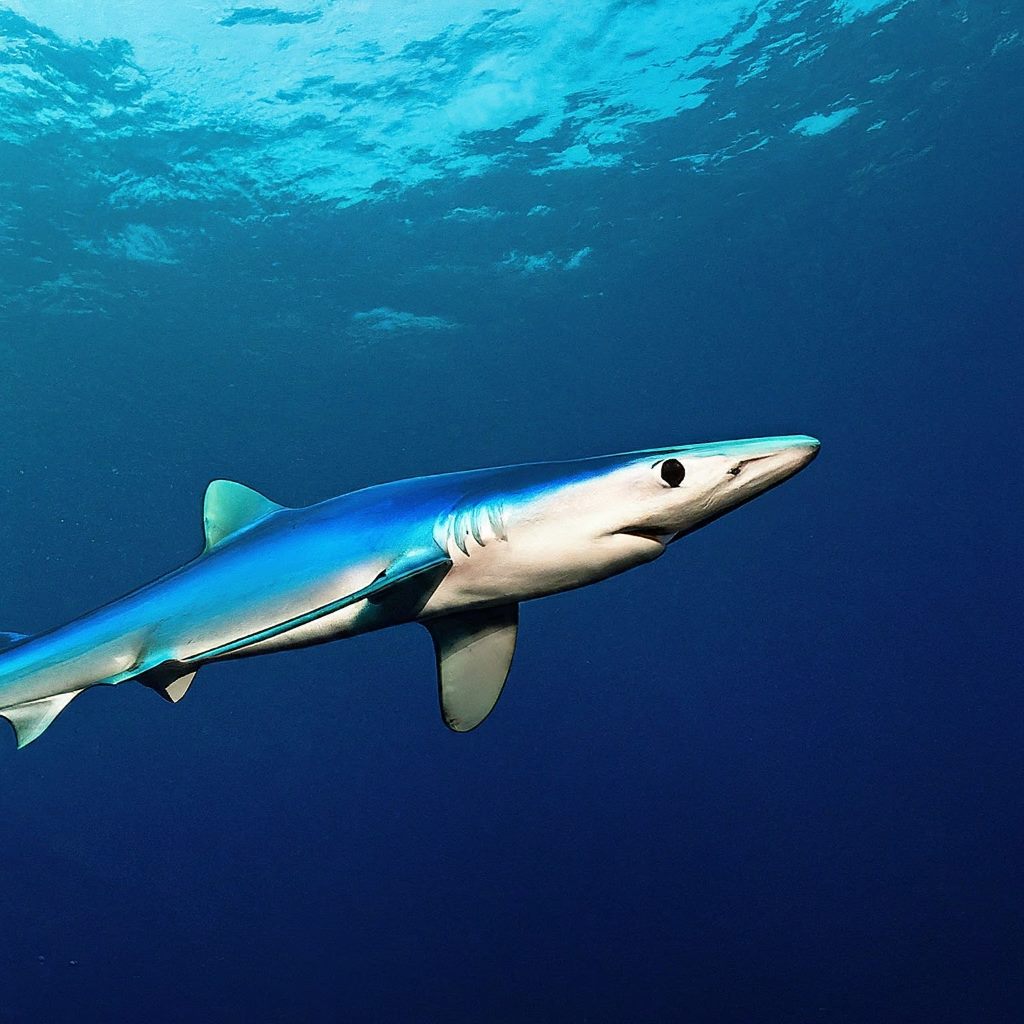
Geographical Distribution:
Blue sharks have a widespread distribution, inhabiting both coastal and open oceanic waters. They are found in various oceanic regions, including the Atlantic, Pacific, and Indian Oceans.
Physical Appearance:
- Sleek and Slender: Possess a streamlined body with a pointed snout and large eyes.
- Distinctive Blue Coloration: Blue on the upper body, transitioning to a lighter shade on the sides and white underbelly.
Food and Diet:
- Versatile Feeders: Consume a varied diet, including fish, squid, and small sharks.
- Pelagic Lifestyle: Primarily dwell in the open ocean, often far from coastlines.
Mode Of Reproduction:
- Ovoviviparous: Females give birth to live young after an internal gestation period.
Conservational Status:
- Near Threatened: Blue sharks face threats from overfishing, particularly due to their vulnerability to longline fisheries.
Interesting Facts:
- Global Distribution: One of the most widely distributed shark species, found in both tropical and temperate seas.
- Migratory Behavior: Undertake extensive migrations, covering vast distances.
9. Bull Shark (Carcharhinus leucas)
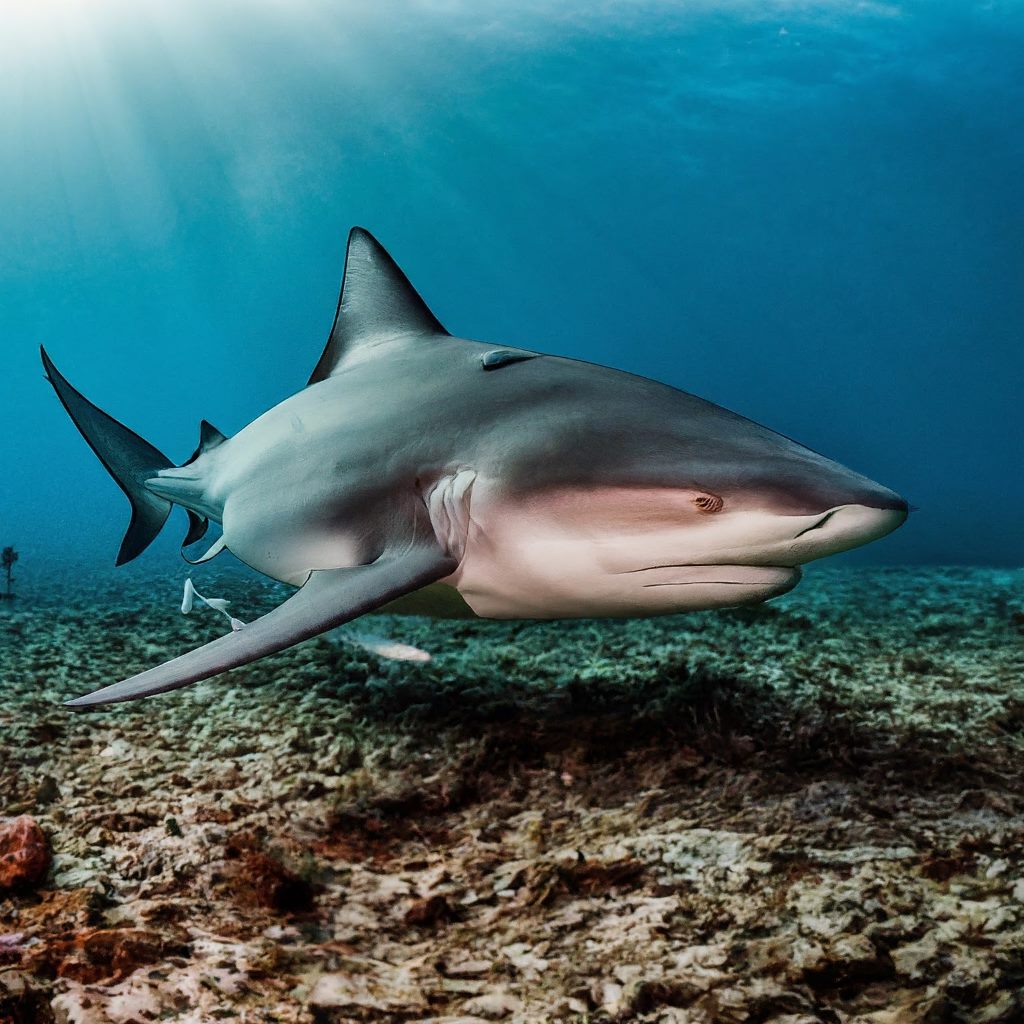
Geographical Distribution:
Bull sharks are highly adaptable and can be found in both saltwater and freshwater environments. They inhabit coastal areas, rivers, and estuaries.
Physical Appearance:
- Robust Build: Stocky and muscular with a broad, blunt snout.
- Gray Coloration: Typically gray on the upper body, transitioning to a lighter shade on the sides and white underbelly.
Food and Diet:
- Versatile Predators: Known for their opportunistic feeding habits, consuming fish, dolphins, and even other sharks.
- Tolerance to Freshwater: Can tolerate low salinity and venture into freshwater rivers.
Mode Of Reproduction:
- Viviparous: Give birth to live young after a gestation period of about a year.
Conservational Status:
- Near Threatened: Bull sharks face threats from habitat loss, pollution, and fishing pressure.
Interesting Facts:
- Inland Migrations: Bull sharks are known to travel significant distances up freshwater rivers.
- Aggressive Behavior: Considered one of the more aggressive shark species, displaying territorial tendencies.
10. Lemon Shark (Negaprion brevirostris)
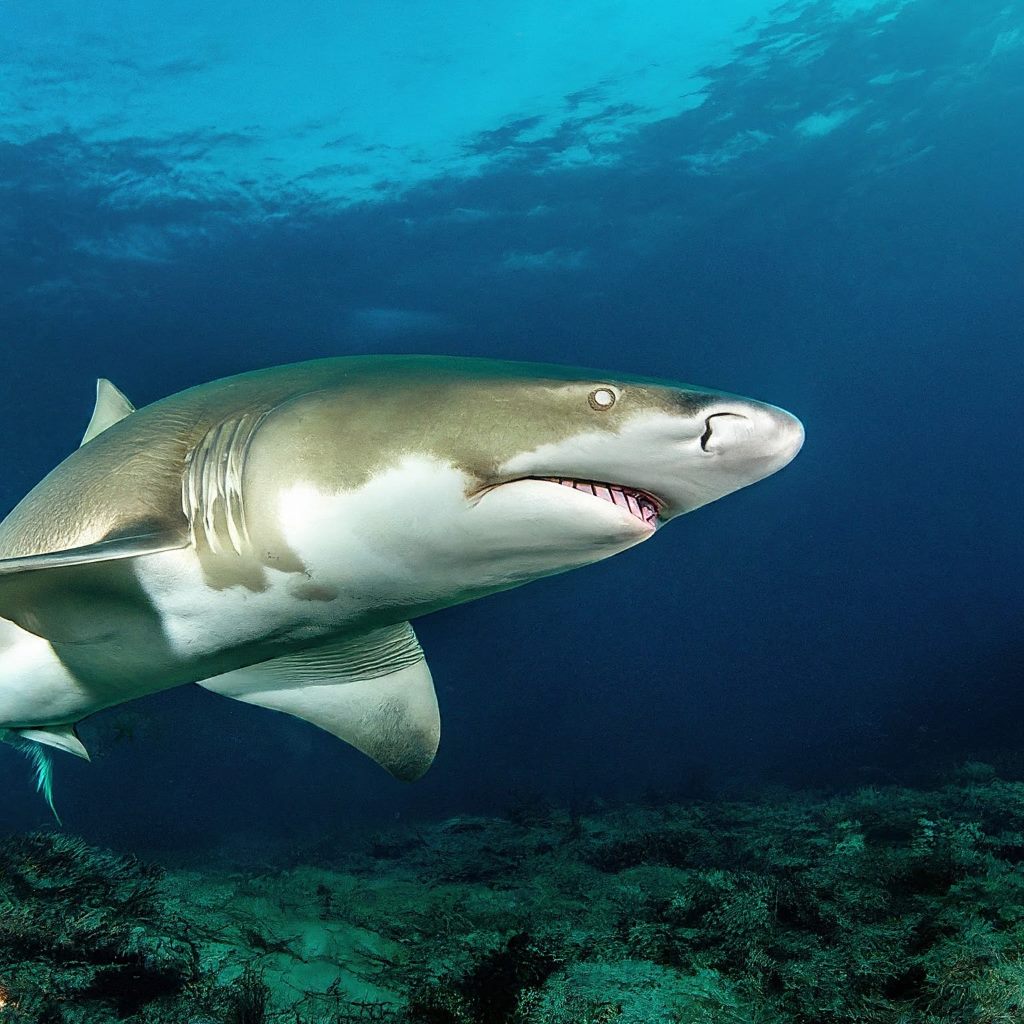
Geographical Distribution:
Lemon sharks inhabit warm coastal waters of the Atlantic and eastern Pacific Oceans. They are commonly found in shallow waters.
Physical Appearance:
- Distinctive Coloration: Display a pale yellow or olive hue, contributing to their name.
- Dorsal Fin Shape: Characterized by a dorsal fin with a black tip.
Food and Diet:
- Varied Diet: Feed on fish, rays, and invertebrates.
- Specialized Teeth: Possess specialized teeth for capturing slippery prey.
Mode Of Reproduction:
- Viviparous: Give birth to live young after a gestation period of about a year.
- Nursery Areas: Utilize mangrove swamps and shallow bays as nursery grounds.
Conservational Status:
- Near Threatened: Bull sharks face threats from habitat loss, pollution, and fishing pressure.
Conclusion: Sharks in the Limelight
Sharks, with their diverse species and captivating features, hold a special place in the natural world and human imagination. From the feared great white to the elusive goblin shark, these creatures have intrigued and inspired us for centuries. As we delve deeper into understanding their biology, behaviors, and ecological roles, it becomes increasingly evident that sharks are not just predators but integral components of marine ecosystems.
Despite their portrayal in popular culture as menacing villains, sharks face numerous challenges, primarily driven by human activities. Overfishing, habitat destruction, and climate change threaten their populations, underscoring the need for concerted conservation efforts. By dispelling myths, promoting awareness, and implementing sustainable practices, we can contribute to ensuring the survival of these apex predators.
In the ever-evolving relationship between humans and sharks, the key lies in fostering coexistence. Balancing our activities with the well-being of these ancient creatures is essential for maintaining the health of our oceans and the intricate web of life within.
FAQs: Exploring Common Questions About Sharks
Q1: Are sharks endangered? While some shark species face threats and are classified as endangered, the status varies among different species. Conservation efforts aim to address these challenges and protect vulnerable populations.
Q2: Do sharks have predators? Adult sharks, as apex predators, have few natural enemies. However, larger sharks or killer whales may prey on smaller shark species.
Q3: How do sharks reproduce? Sharks employ various reproductive strategies, including viviparity, oviparity, and ovoviviparity. The method depends on the species.
Q4: Are there freshwater sharks? Yes, some shark species, such as bull sharks, are known to inhabit both saltwater and freshwater environments.
Q5: Can sharks get cancer? Sharks, including their cartilaginous tissues, can develop tumors. However, the incidence of cancer in sharks is relatively low compared to other animals.
Q6: What is the largest shark species? The whale shark holds the title for the largest shark species, reaching lengths of up to 40 feet or more.
Q7: Are sharks intelligent? Sharks demonstrate remarkable instincts and adaptations, but their intelligence is still a subject of ongoing research and debate among scientists.
Q8: How fast can sharks swim? Shark speeds vary among species. Some, like the shortfin mako, can reach speeds of over 40 miles per hour.
Q9: Can sharks smell blood from miles away? Sharks have an acute sense of smell, and while the idea of smelling blood from miles away is an exaggeration, they can detect scent trails over considerable distances.
Q10: Are sharks cold-blooded? Sharks are poikilothermic, meaning their body temperature is influenced by their environment. They can maintain a higher temperature than the surrounding water, giving them a degree of warmth.
